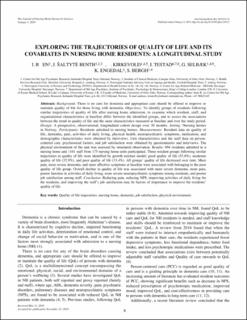| dc.description.abstract | Background: There is no cure for dementia and appropriate care should be offered to improve or maintain quality of life for those living with dementia. Objectives: To identify groups of residents following similar trajectories of quality of life after nursing home admission, to examine which resident, staff, and organizational characteristics at baseline differ between the identified groups, and to assess the associations between the trend in quality of life and the same characteristics measured at baseline and over the study period. Design: A prospective, observational, longitudinal cohort design over 30 months. Setting: Nursing homes in Norway. Participants: Residents admitted to nursing homes. Measurements: Resident data on quality of life, dementia, pain, activities of daily living, physical health, neuropsychiatric symptoms, medication, and demographic characteristics were obtained by interviews. Unit characteristics and the staff data on person-centered care, psychosocial factors, and job satisfaction were obtained by questionnaires and interviews. The physical environment of the unit was assessed by structured observation. Results: 694 residents admitted to a nursing home and 1161 staff from 175 nursing home units participated. Three resident groups following similar trajectories in quality of life were identified by growth mixture model; good quality of life (53.6%), moderate quality of life (32.9%), and poor quality of life (13.4%). All groups’ quality of life decreased over time. More pain, more severe dementia, and more affective symptoms at baseline were associated with belonging to the poor quality of life group. Overall decline in quality of life was associated with more severe dementia, more pain, poorer function in activities of daily living, more severe neuropsychiatric symptoms among residents, and poorer job satisfaction among staff. Conclusion: Reducing pain, reducing NPS, improving activities of daily living for the residents, and improving the staff’s job satisfaction may be factors of importance to improve the residents’ quality of life. | en_US |
| dc.description.sponsorship | The REDIC-NH study was administrated by the Centre for Old Age Psychiatric Research, Innlandet Hospital Trust, and was initiated by the Norwegian Health Directorate, which also provided funding for the data collection. The first author’s Ph. D. study was funded by the Research Council of Norway. | en_US |
